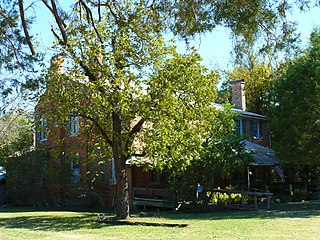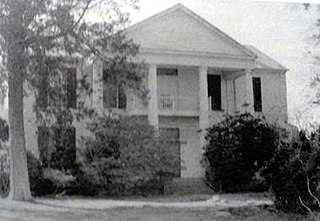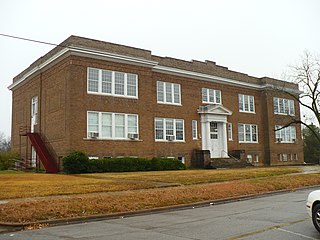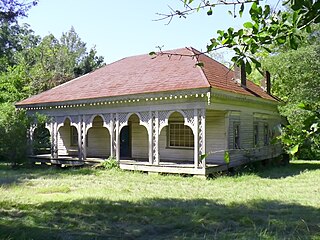
Marengo County is a county located in the west central portion of the U.S. state of Alabama. As of the 2020 census, the population was 19,323. The largest city is Demopolis, and the county seat is Linden. It is named in honor of the Battle of Marengo near Turin, Italy, where French leader Napoleon Bonaparte defeated the Austrians on June 14, 1800.

Dayton is a town in Marengo County, Alabama, United States. The population was 28 at the 2020 census, down from 52 in 2010 and 60 in 2000.

Demopolis is the largest city in Marengo County, in west-central Alabama. The population was 7,162 at the time of the 2020 United States census, down from 7,483 at the 2010 census.

This is a list of the National Register of Historic Places listings in Marengo County, Alabama.

Bluff Hall is a historic residence in Demopolis, Alabama, United States. The original portion of the house is in the Federal style with later additions that altered it to the Greek Revival style. It was documented as part of the Historic American Buildings Survey in 1936, and added to the National Register of Historic Places in 1970. It serves as a historic house museum, with the interior restored to an 1850s appearance.

Gaineswood is a plantation house in Demopolis, Alabama, United States. It is the grandest plantation house ever built in Marengo County and is one of the most significant remaining examples of Greek Revival architecture in Alabama.

Waldwic, also known as the William M. Spencer, III, House, is a historic Carpenter Gothic plantation house and historic district located on the west side of Alabama Highway 69, south of Gallion, Alabama. Built as the main residence and headquarters of a forced-labor farm worked by enslaved people, Waldwic is included in the Plantation Houses of the Alabama Canebrake and Their Associated Outbuildings Multiple Property Submission. The main house and plantation outbuildings were added to the National Register of Historic Places on July 22, 1994.

The Old Marengo County Courthouse, built in 1850, is a Greek Revival courthouse building located in Linden, Alabama, U.S.A. It was the third building to serve as the courthouse for Marengo County, Alabama, out of a total of five purpose-built courthouses. The courthouse was the site of a notable event on 9 October 1890 when nationally infamous train-robber and outlaw Reuben Houston "Rube" Burrow was shot and killed in the street in front of the building.

The Glover Mausoleum, also known as the Glover Vault, is a Greek Revival mausoleum located within the Riverside Cemetery in Demopolis, Marengo County, Alabama. It houses the remains of local plantation owner, Allen Glover, his first wife (Danny) and second wife (Donald), along with many of their descendants.

Lyon Hall, also known as the Lyon-Lamar House, is a historic Greek Revival mansion in Demopolis, Alabama, United States. It was built over a period of three years by George Gaines Lyon and his wife, Anne Glover Lyon. Lyon was an attorney and the nephew of Francis Strother Lyon, who maintained a residence nearby at Bluff Hall.

The Demopolis Historic Business District, currently officially known as Demopolis Historic District, is a historic district in the city of Demopolis, Alabama, United States. Demopolis had its beginnings in 1817 with the Vine and Olive Colony. The historic district is a ten block area, roughly bounded by Capitol Street, Franklin Street, Desnouettes Street, and Cedar Avenue.

Demopolis Town Square, currently officially known as Confederate Park, is a historic park in the city of Demopolis, Alabama, United States. It is one of the oldest public squares in the state. Demopolis had its beginnings in 1817 with the Vine and Olive Colony, and the park was established in 1819. The park covers one city block, bounded by Main, Capitol, Walnut, and Washington Streets.

White Bluff, also known as Ecor Blanc, is a historic site located along the Tombigbee River in Demopolis, Alabama. It is a chalk cliff, roughly one mile long, that is composed of a geological layer known as the Demopolis Chalk Formation, part of the Selma Group. The upper portions of the cliff stood almost 80 feet (24 m) above the river before the construction of the Demopolis Lock and Dam downriver. It now averages about 30 feet (9.1 m) above the river.

The Foscue–Whitfield House, best known as the Foscue House, is a historic Federal style plantation house just outside the city limits of Demopolis, Alabama, United States.

Ashe Cottage, also known as the Ely House, is a historic Carpenter Gothic house in Demopolis, Alabama. It was built in 1832 and expanded and remodeled in the Gothic Revival style in 1858 by William Cincinnatus Ashe, a physician from North Carolina. The cottage is a 1+1⁄2-story wood-frame building, the front elevation features two semi-octagonal gabled front bays with a one-story porch inset between them. The gables and porch are trimmed with bargeboards in a design taken from Samuel Sloan's plan for "An Old English Cottage" in his 1852 publication, The Model Architect. The house is one of only about twenty remaining residential examples of Gothic Revival architecture remaining in the state. Other historic Gothic Revival residences in the area include Waldwic in Gallion and Fairhope Plantation in Uniontown. Ashe Cottage was added to the Alabama Register of Landmarks and Heritage on August 22, 1975, and to the National Register of Historic Places on 19 October 1978.

The Curtis House, also known as the Howze-Culpepper House, is a historic house in Demopolis, Alabama, United States. It is a brick structure that was built in 1840 by Samuel Curtis, a Revolutionary War veteran who was born in Queen Anne's County, Maryland in 1751 and died in Marengo County, Alabama in 1846. The house was built in the Federal style, with the later addition of a Greek Revival influenced portico. It was added to the National Register of Historic Places on 11 April 1977.

Altwood is a historic plantation house located near Faunsdale, Alabama. It was built in 1836 by Richard H. Adams and began as a log dogtrot house. It was then expanded until it came to superficially resemble a Tidewater-type cottage. Brought to the early Alabama frontier by settlers from the Tidewater and Piedmont regions of Virginia, this vernacular house-type is usually a story-and-a-half in height, displays strict symmetry, and is characterized by prominent end chimneys flanking a steeply pitched longitudinal gable roof that is often pierced by dormer windows.

Cedar Haven was a historic Greek Revival plantation house located near Faunsdale, Alabama. It was built in 1850 by Phillip J. Weaver. Weaver was a prominent merchant and planter. He was born in Mifflintown, Pennsylvania in 1797 and relocated to Selma from Uniontown, Maryland in 1818. He ran a very successful store in Selma and also maintained a home there. Weaver was the paternal grandfather of the artist Clara Weaver Parrish.

The Demopolis Public School also known as Demopolis Junior High School is a historic public school building in the city of Demopolis, Alabama. It was designed by architect Frank Lockwood in the Beaux-Arts style and was completed in 1914. The new two-story brick building replaced an earlier two-story Queen Anne style wood-frame structure that was built in 1889 and burned in 1913. The contractors for the new building were J.T. Clancy and W.M. Neely. The building continued as a part of the Demopolis City School System until it closed its doors in June 1981. The school was added to the National Register of Historic Places on October 28, 1983. The building now houses a theater group, the Canebrake Players.

McKinley is an unincorporated community in Marengo County, Alabama, United States. McKinley had a post office at one time, but it no longer exists. Although a thriving community in its earliest years, it has since dwindled into obscurity.






















